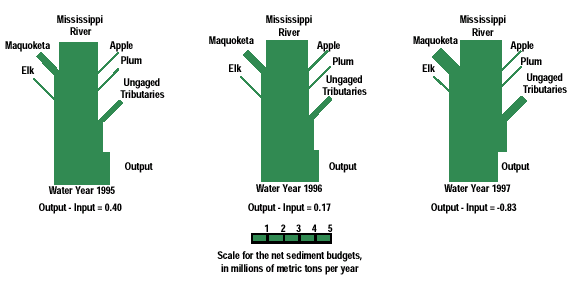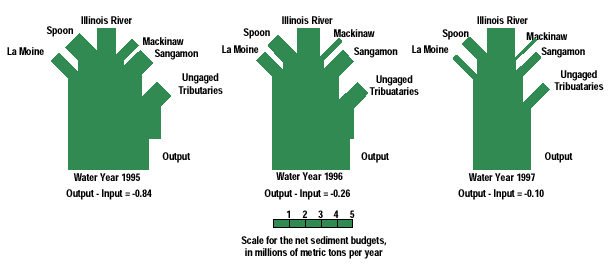|
PSR 99-11 December 1999 Suspended Sediment Budgets for Pool 13 and the La Grange Pool of the Upper Mississippi River Systemby Robert F. Gaugush |
||
|
Understanding the sources and fate of sediments delivered to the Upper Mississippi River System (UMRS) is important in determining the system’s long-term response to impoundment by a series of locks and dams. The Upper Midwest Environmental Sciences Center, in cooperation with the USGS Water Resources Division (Illinois and Iowa Districts) and the States of Illinois and Iowa, selected Pool 13 on the Mississippi River and the La Grange Pool on the Illinois River as initial sites for developing pool-scale budgets for suspended sediment. The study was designed to determine if the two pools trap suspended sediments or if they are in equilibrium with respect to their suspended sediment budgets (inputs = outputs). Six gaging sites were placed on Pool 13, one upstream of the pool on the Mississippi River, one downstream of the pool, and one each at the major tributaries to the pool (i.e., the Apple and Plum Rivers on the eastern side and the Maquoketa and Elk Rivers on the western side). The La Grange Pool also received six gaging sites, one upstream of the pool on the Illinois River, one downstream of the pool, and one each on the major tributaries to the pool (i.e., the Spoon and La Moine Rivers on the northern side and the Sangamon and Mackinaw Rivers on the southern side). Estimates of the ungaged areas contribution to the suspended sediment load, for both Pool 13 and the La Grange Pool, were made by assuming that the ungaged loads were similar (on an areal basis) to the loads from the gaged tributaries. Gaged output at Pool 13 was between 3.07 and 3.64 million metric tons (metric ton = 1000 kilograms) of suspended sediment per year during the 1995-1997 water years (Figure 1). Most (76% in 1995, 74% in 1996, and 66% in 1997) of the sediment input to Pool 13 was supplied by the Mississippi River. While the gaged tributaries accounted for about 3% of the drainage area and water discharge, they provided a greater fraction (16% in 1995, 17% in 1996, and 22% in 1997) of the suspended sediment load. These loads were more than five times the loads expected based solely on these tributaries’ contribution to the overall drainage area or water input. The estimated contributions of sediment from ungaged tributaries (8% in 1995, 8% in 1996, and 11% in 1997) were about half those from the gaged tributaries. |
||
|
||
|
The data suggest sediment export (output exceeding input) in 1995, a balance in 1996, and marked sediment trapping (output less than input) in 1997. Two different processes occurred in water year 1997 that resulted in a positive sediment budget (i.e., sediment storage in the pool). First, tributary loads (and, as a result, the ungaged contribution) were greater than during the previous two years. Second, the pool output was considerably lower than the previous two years. Given these two different processes, it would be useful to identify factors causing the higher tributary loads and lower suspended sediment export rates in 1997. The La Grange Pool output was between 3.7 and 5.0 million metric tons of suspended sediment per year during the 1995-1997 water years (Figure 2). In all years, the Illinois River above the La Grange Pool accounted for less than 50% of the suspended sediment load to the pool (19% in 1995, 25% in 1996, and 45% in 1997). The gaged tributaries accounted for only 34% of the total drainage area, but they accounted for a much greater fraction of the sediment load (61% in 1995, 56% in 1996, and 41% in 1997). These loads were 1.2 to 2 times those expected based solely on these tributaries’ contributions to the overall drainage area or on water input. The total contribution of ungaged tributaries to the La Grange Pool was estimated to be 34% of that from the gaged tributaries. |
||
|
||
|
The 1995 water year (a “wet” year) was associated with considerable sediment trapping (input > output) while the water years of 1996 and 1997 (closer to “normal” hydrologic years) appear to be in balance (less than a 5% difference between input and output). A more detailed examination of the data may explain for the changes in the sediment budget with respect to changes in hydrology and sediment delivery. Sediment trapping may occur in flood years due to sedimentation in inundated areas of the floodplain during periods of high water levels. A comparison of the sediment budgets for Pool 13 and the La Grange Pool reveals some interesting features of these two navigation pools. Pool 13 is primarily dependent on its mainstem (Mississippi River) in terms of sediment loads, whereas the La Grange Pool is more tributary dependent. This is largely a result of their relative hydrologic “position” in their respective rivers. This position can be expressed as the ratio of the “local” drainage area (that area between the next upstream lock and dam and pool’s lock and dam) to the total drainage area of the pool. For Pool 13, the local drainage area is only 4% of the total area and mainstem loads, consequently, predominate the sediment budget. On the other hand, for the La Grange Pool, the local drainage area is 45% of the total area and tributary sediment loads comprise a much larger fraction of the total load. While the Pool 13 drainage area (221,700 km 2 ) is more than three times that of the La Grange Pool (69,300 km 2 ), suspended sediment discharge from Pool 13 is considerably lower (70% in 1995, 75% in 1996, and 83% in 1997) than the sediment discharge from the La Grange Pool. The implication is that the Illinois River and its tributaries in the area of the La Grange Pool contribute much higher suspended sediment loads on an areal basis than the Mississippi River and its tributaries at Pool 13. These results are not surprising considering the great differences in the lands drained by these two rivers. Watersheds along the Illinois River drain some of the most fertile and intensely farmed lands in the Midwest. Although tributaries to Pool 13, such as the Maquoketa River, drain primarily agricultural land, much of the watershed above Pool 13 does not have the agricultural activity of the Illinois River Valley. |
||
|
This report is a product of the Long Term Resource Monitoring Program for the Upper Mississippi River System. For further information, contact Dr. Robert F. Gaugush Project Status Reports (PSRs) are preliminary documents whose purpose is to provide information on scientific activities. Because PSRs are only subject to internal peer review, they may not be cited. Use of trade names does not imply U.S. Government endorsement of commercial products. All Project Status Reports are accessible through the Upper Midwest Environmental Sciences Center’s website at http://umesc.usgs.gov/reports_publications/psrs/umesc_psr.html |
Page Last Modified: April 17, 2018



